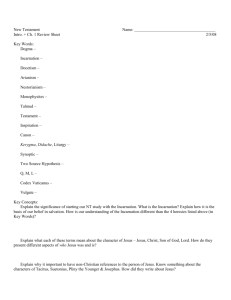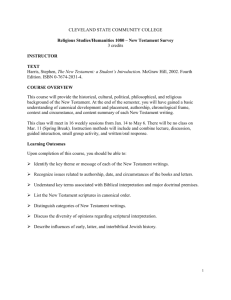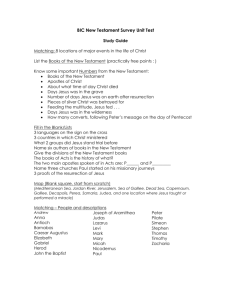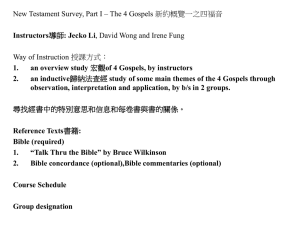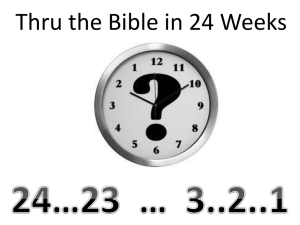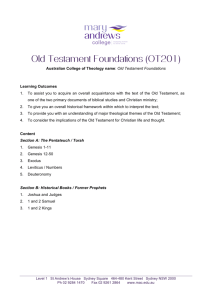Week 2 - Apologetics Class
advertisement
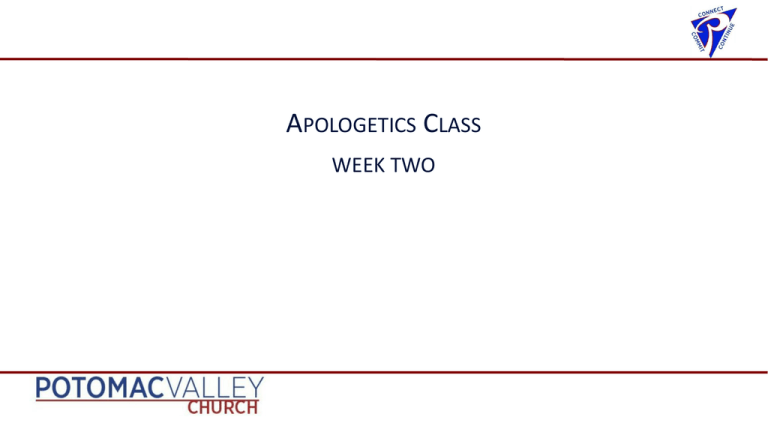
APOLOGETICS CLASS WEEK TWO INTRODUCTION TO WEEK TWO • (Video shown from Raiders of the Lost Ark with the scene where Indiana Jones tells the U.S. Government agents about the suspected fate of the Ark of the Covenant) • What do you know about the Ark of the Covenant? • How accurate is Raiders of the Lost Ark? POPULAR CULTURE ORIENTATION • The Ark of the Covenant was stored in the Temple of Solomon o True – the First Temple or Solomon’s Temple did store the Ark • Pharoah Shishak (aka Sheshonk I) invaded Jerusalem o True – 1 Kings 14:25 and 2 Chronicles 12:1-12 (circa 930s BC) • Shishak took the Ark of the Covenant. o Possibly – It is equally possible the Ark disappeared when the Babylonians, under Nebuchadnezzar II, destroyed Jerusalem and the Temple in 587BC • The Ark is hidden in the Well of Souls in the Egyptian city of Tanis o This Well of Souls was made up for the movie o There is a cave called Well of Souls (aka Pit of Souls, Cave of Spirits, Well of Spirits ) under the Dome of the Rock POPULAR CULTURE ORIENTATION • Tanis was wiped clean off the map by a year-long sandstorm o Tanis exists and is one of the places associated with Moses as an infant o Tanis was an important commercial and strategic city until it was threatened with inundation by Lake Manzala, possibly as a natural change in the Nile River’s tributaries, in the 6th century AD, when it was finally abandoned • Many people’s knowledge about the Bible, its history and its reliability comes from popular culture rather than informed, scholarly sources WHAT DOES HOLY BIBLE MEAN? • By the time of Jesus, many Jewish groups had taken to calling the Jewish Tanakh “scriptures” and referring to them as “holy”. • Egyptian traders exported papyrus to Greece from the Phoenician seaport of Byblos. o The Greeks adopted a form of the name Byblos to refer to books. o From the Greek came the Latin biblia which became Bible in English. • The Christians continued these labels and we now have the Holy Bible. IS THE BIBLE ACCURATE? WHY BIBLE RELIABILITY IS IMPORTANT • John 1:1-2, 14 In the beginning was the Word, and the Word was with God, and the Word was God. He was with God in the beginning…The Word became flesh and made his dwelling among us. We have seen his glory, the glory of the one and only Son, who came from the Father, full of grace and truth. o The Word became flesh – Jesus is the Word o The Word (Jesus) was there at the beginning in Genesis o If you believe the Bible is accurate and historically reliable, then you must, by definition, believe that Jesus is Lord! WHY BIBLE RELIABILITY IS IMPORTANT • 2 Timothy 3:16-17 All Scripture is God-breathed and is useful for teaching, rebuking, correcting and training in righteousness, so that the servant of God may be thoroughly equipped for every good work. o God’s message is inspired • 2 Peter 1:20-21 Above all, you must understand that no prophecy of Scripture came about by the prophet’s own interpretation of things. For prophecy never had its origin in the human will, but prophets, though human, spoke from God as they were carried along by the Holy Spirit. o God’s messengers are inspired • The medium to record the message is not inspired leading some to doubt the accuracy of God’s message OLD TESTAMENT OLD TESTAMENT HISTORY • Old Testament was written over the period of time between 2000BC – 400BC • The Israelites left no archeological footprint until 1200BC (between the Judges and Saul being installed as king) o 800 years of history not corroborated by extra-biblical sources • No one really knows when the OT was established as canon o 450BC -587BC is general consensus o Josephus listed the existing Old Testament books as being canon in 95AD THE TANAKH • The Tanakh is the Hebrew equivalent of what we call the Old Testament • Originally called Mikrah meaning “that which is read” as the texts were read aloud in public • It is ordered differently than the Old Testament and divided into three parts o Torah (the law) o Nevi’im (the prophets) o Ketuvim (the writings) THE PENTATEUCH • The Pentateuch are collectively the first five books of the Tanakh (our Old Testament) and normally the most contested o The Pentateuch falls squarely within the 800 years of history uncorroborated by extra-biblical sources o Written by Moses likely during the Exodus as he collected details about Abraham and his descendants o Biblical sources outside the Pentateuch that tell of Moses’ authorship include Joshua 8:31, Mark 12:26, Luke 20:28, Acts 3:22 and Romans 10:5 • Moses knew how to read and write? o Moses was given the written law and Ten Commandments by God o Moses had been educated in the royal courts of Pharaoh and knew how to read and write THE AUTHORITATIVE OLD TESTAMENT • There is no “smoking gun”, no original writings remain • There are three key sources to an authoritative Old Testament o Masoretic Text (500-1000AD) – written in Hebrew o Septuagint (250-100BC) – written in Greek o Dead Sea Scrolls (150-100BC) – written in Hebrew THE MASORETIC TEXT • Masoretes were rabbis who made it their work to correct faults that had crept into the text during the Babylonian captivity • The oldest and most complete Masoretic Text manuscript is the Aleppo Codex dating from the 10th century o Missing the Torah section o It was complete and located in Syria in 1947 when rioters angry at the creation of modern Israel burned the synagogue housing it o It disappeared until 1958 when a Syrian Jew smuggled it into Israel and gave it to the state for safekeeping o The missing pages are a mystery as evidence points to the fire never reaching the codex and witnesses stating it was still complete shortly after the fire and two pages having turned up in 1982 and 2007 THE SEPTUAGINT • Greek translation of the Hebrew scriptures • Greek was the language of business and government across much of the Mediterranean and the Middle East • Jewish population had been dispersed resulting in a Jewish population who did not read or speak Hebrew • This necessitated a translation of the scriptures into a language accessible to the Jewish population at large THE DEAD SEA SCROLLS • Found in the Qumran Caves of the West Bank of Israel in 1947 • Dating from 150BC - 100BC, the Dead Sea Scrolls contain the oldest Hebrew manuscripts of the Old Testament • They contain fragments of every Old Testament book except Esther o 40,000 fragments representing parts of over 500 ancient books o Included in those 500 books are 100 copies of Old Testament books o Contains the entire book of Isaiah including Isaiah 53 prophesizing Jesus SO WHAT DOES IT MEAN? • Three sources in two different languages • 1000 years represented from earliest Dead Sea Scroll to latest Masorete Text, 1000 years of passing along God’s word in writing • When compared against one another, there are only minor deviations! • Compare it to other easily recognizable ancient texts for reliability AUTHOR BOOK WRITTEN EARLIEST COPY TIME GAP # OF COPIES Caesar The Gallic Wars 100BC-44BC 900AD 1000 Years 10 360BC 800AD 1160 Years 15 100AD 1100AD 1000 Years 20 Plato Tacitus Annals NEW TESTAMENT NEW TESTAMENT BASICS • New Testament consists of twenty-seven books o o o o Four Gospels The Acts of the Apostles Twenty-one Epistles The Book of Revelation • Most of the New Testament was written between 68AD – 100AD • While no original texts remain, there are more than 5000 copies of the New Testament in the Greek language alone • Including copies in other languages, there are more than 40,000 complete and partial manuscripts of the New Testament THE GOSPELS • The first of the Gospels written was Mark o Oldest of the Gospels written in 50AD-70AD by John Mark but authorship is disputed o Oldest existing copy is from 350AD o Mark likely drew upon Paul and Peter as sources for his Gospel o Written only 20 – 40 years after Jesus o That is equivalent of writing about a 1955 event in 1975 – 1995 (e.g., writing about Rosa Parks…people know what happened!) o Served as a source for Matthew and Luke THE ACTS OF THE APOSTLES & EPISTLES • Acts o Credited to Luke who was associated with Paul o Written in 63AD-70AD period o Oldest existing copy is from 250AD • Epistles o Written by James (brother of Jesus), Jude (brother of Jesus), John and Peter, who all walked with Jesus, and Paul who had a close encounter of the spiritual kind with Jesus o The Epistles were letters to the churches meant to be read aloud to the church o The Epistles reiterate many of the doctrinal events of the Gospels o People who were present at various events in the Gospels would have also been alive yet there is no recorded dispute of the record REVELATIONS • Revelations was written by John o o o o Written in 90AD - 96AD Oldest existing copy is from 150AD - 200AD Regarded as a book of prophecy today Regarded as a book of encouragement to Christians when it was written as the Romans were militantly enforcing worshipping the Roman Emperor. For those who said, “Jesus is Lord” this was to be a time of heavy persecution IS THERE CONFLICTING INFORMATION? • There is not conflicting information but there is information that requires study and understanding • Example: the Sermon on the Mount or Sermon on the Plain? o Matthew 5-7 is the Sermon on the Mount o Luke 6:17-49 is the Sermon on the Plain o Other than location, this appears to be the same event based on what Jesus is preaching o No conflict in the message Jesus taught in either place o The Bible is not necessarily a play-by-play, word-for-word historical document but is meant to transmit ideas (e.g., God’s inspired message through inspired messengers) IS THERE CONFLICTING INFORMATION? • Bible is not necessarily a play-by-play, word-for-word historical document but is meant to transmit ideas (e.g., God’s inspired message through inspired messengers) • Where is the evidence that the Bible is not a word-for-word historical account? o Acts 2:40 “With many other words…” not everything is captured here! o John 20:30-31 Jesus did many other things that John did not record. He told us what we need to know o John 21:25 Jesus did so many other things that it would takes volumes to record it all IS THERE A CONFLICT? • Hebrews 6:4-6 o It is impossible for those who have once been enlightened, who have tasted the heavenly gift, who have shared in the Holy Spirit, who have tasted the goodness of the word of God and the powers of the coming age and who have fallen away, to be brought back to repentance. To their loss they are crucifying the Son of God all over again and subjecting him to public disgrace. • Does Hebrews 6:4-6 conflict with other passages concerning repenting and being restored? o Letter is meant for the Hebrews (Jewish converts to Christianity) o Openly disavowing Jesus as Lord and reverting to the Law for salvation o Approving of the actions of Jesus’ murderers and would crucify Jesus again if it were within their power o Impossible for them to be brought to repentance in this frame of mind TWO LEGITIMATE AREAS OF CONCERN • Mark 16:9-20 o Vocabulary and themes are not considered consistent with the rest of Mark o In two of the oldest Greek manuscripts and a number of other versions, Mark ends at 16:8 o A more satisfying ending may have been added but ending it there would be consistent with a theme of fear caused by God’s work through Jesus (Mark 5:15; Mark 5:33; Mark 9:6) • John 7:53 - 8:11 o Not included in earliest texts of John o Not cited by any early church leader o May have been circulated as some sort of independent account and inserted into John later o Did it occur? It is heavy in detail leading to a belief that incident occurred SO WHAT DOES IT MEAN? • The earliest manuscript of a New Testament text is a business card sized fragment (Rylands Library Papyrus P52) from Gospel of John dating to first half of the 2nd Century (within 100 years of autograph) • The first complete copies of single New Testament books appear around 200AD, and the earliest complete copy of the New Testament, the Codex Sinaiticus, dates to the 4th century • With over 45,000 reference points, the New Testament is one of, if not THE, most corroborated ancient text in existence • Any major discrepancies come from translation to other modern languages and the use of source materials that are themselves translations CANON WHAT IS CANON? • Old Testament Canon o o o o Writings that claim for themselves as being from God Writings that were considered God’s words by the Jews Writings that were considered scripture by Jesus and his followers Consistent teachings with other parts of scripture • New Testament Canon o Must be written by an apostle o Must present correct doctrine o Must bear fruit (ref. 2 Timothy 3:16) DO NOT LOSE SIGHT OF THE FOREST • Do not get so hung up on preciseness of words used or translation versions used, that you lose sight of the big picture – the message that God is trying to get across in any particular area • When the big picture is obvious, do not allow divisions based on translations to be a point of divisiveness when reaching out to people
